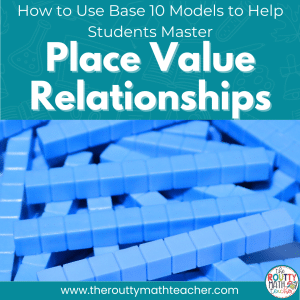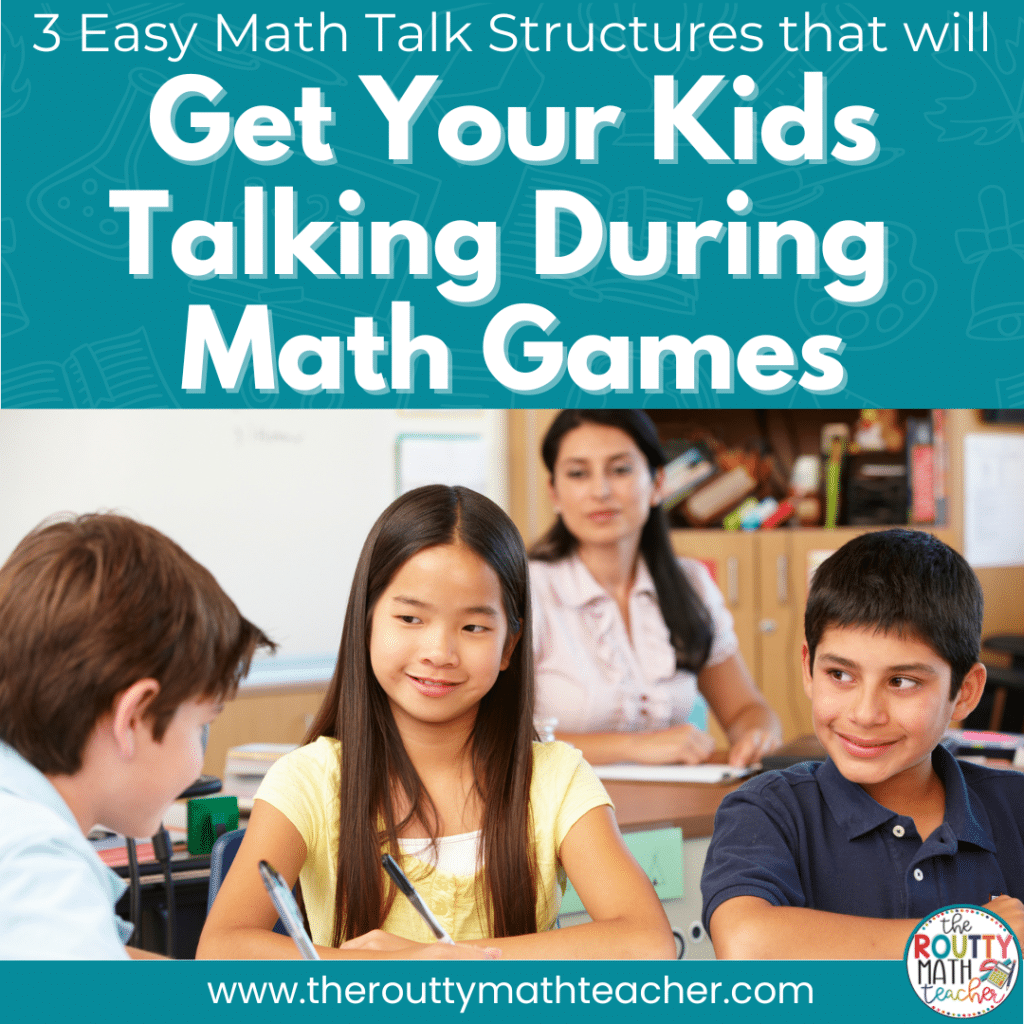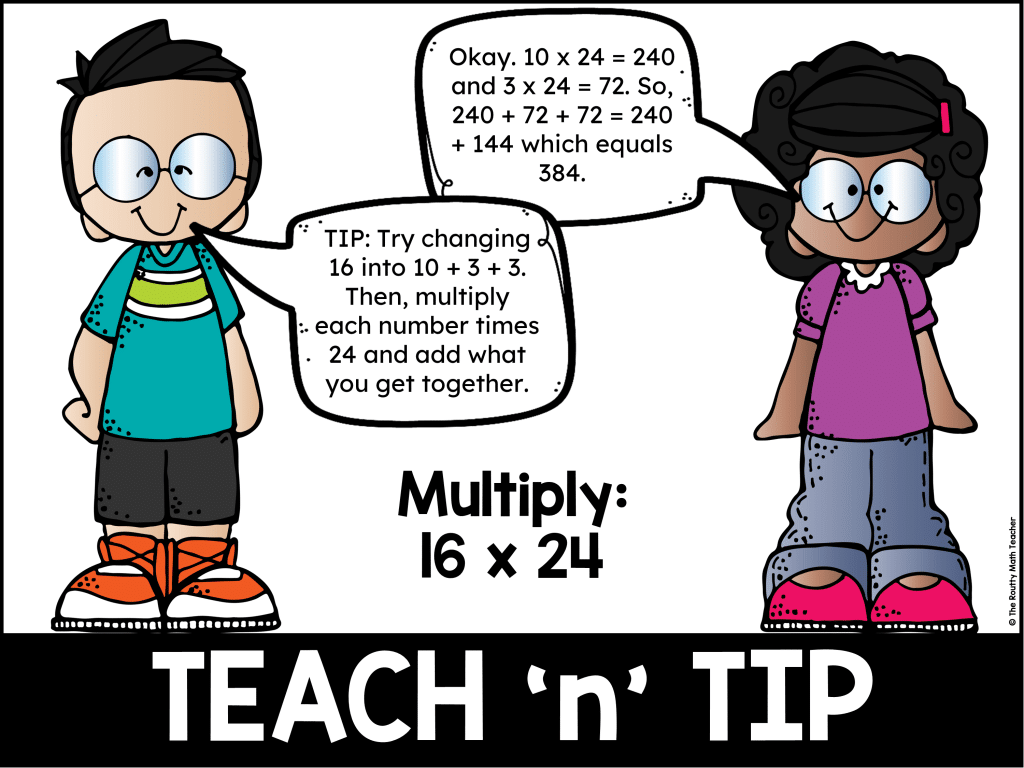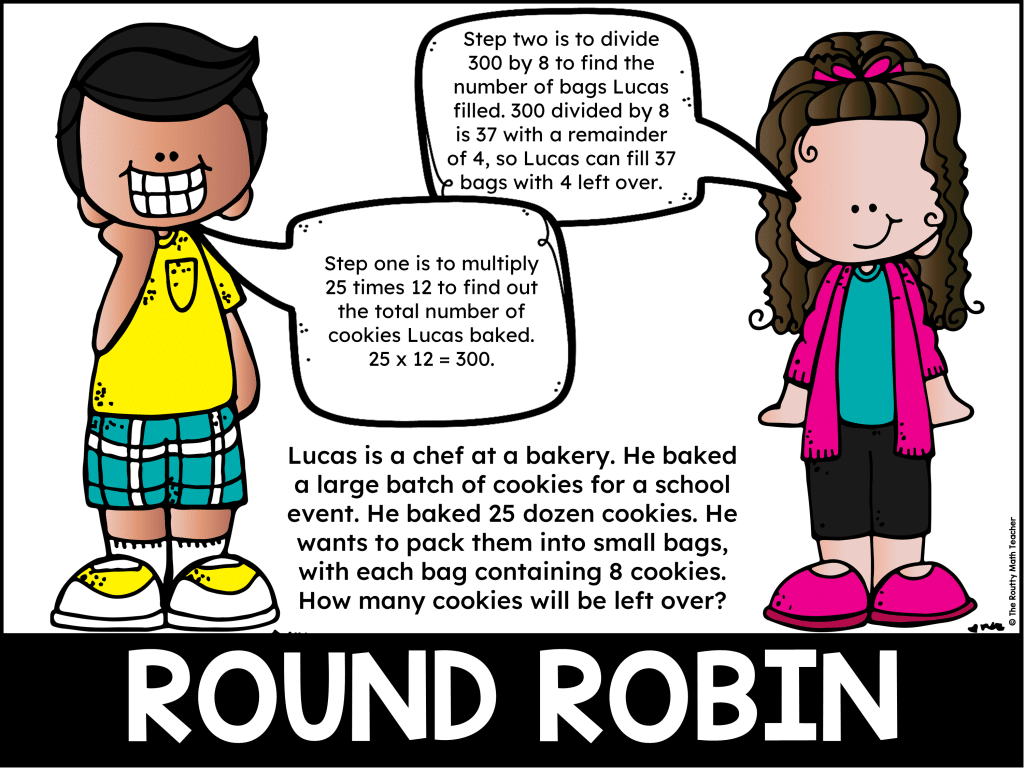
Partner Math Games: 3 Cooperative Conversations

Collaborative math talk structures during partner math games promote deeper understanding, clarify misconceptions, and reinforce math concepts and skills. Through community building and intentional strategies, teachers can create a supportive math community that enhances engagement, motivation, and peer learning. In this blog post, I explore the importance of building a math community and share effective strategies and collaborative math talk structures to encourage student participation during math games.
Student A: Ready?
Student B: (Student B nods.)
Student A: Three, two, one . . . Showdown!
(Students A and B simultaneously show the writing on their dry erase boards to reveal their simplified expressions for 4 + 3 x (6-2).)
Student A: I got 4 + 3 x 4, which equals 4 + 12. My answer is 16. What about you?
Student B: Oh, I got 4 + 3 x 4 as well. Then I got 4 + 3 is 7, so my answer is 7 x 4, which is 28. (Student B raises his brows and narrows his eyes as he focuses on Student A’s solution.) I think I made a mistake.
Student A: You got the expression right, so let’s start there. We do multiplication before addition. Remember the GEMS strategy Ms. Routt showed us? (Student A points to the GEMS chart in her math notebook.)
Student B: Oops! You’re right. We need to multiply before adding. 3 x 4 is 12, so, it should be 4 + 12, which equals 16.
Student A: Exactly! We have to follow the order of operations: grouping symbols first, then multiplication and division, and finally addition and subtraction.
Student B: Thanks for your help. I’ll remember to check the order next time.
The Power of Collaboration
The dialogue between the students illustrates the rich mathematical conversation that can happen when students work collaboratively while playing partner math games.
Using collaborative math games provides opportunities for students to discuss and explain their reasoning, clarify misconceptions, challenge each other’s thinking, and arrive at more comprehensive solutions.
Collaborating during partner math games also nurtures practical communication skills and teaches students to articulate their thoughts, actively listen to others, and engage in respectful exchanges.
In addition, collaborative math games increase students’ level of engagement and motivation, promote peer-to-peer learning and support, and help develop social skills.
But, this doesn’t happen overnight. Creating a supportive learning environment requires intentionality that begins on the first day of school.
In the following paragraphs, we will explore the importance of building a math community and I share effective strategies and collaborative math talk structures to encourage student participation during partner math games.
The Importance of Community Building
Creating an inclusive and collaborative learning environment is vital in any classroom, especially when it comes to teaching mathematics. Engaging students in math games not only makes learning enjoyable but also provides an opportunity to foster meaningful math discussions.
But, how do we get there?
Building a strong sense of community in the classroom is crucial for fostering a positive and supportive learning environment. Community building enhances engagement, promotes collaboration, and boosts students’ confidence in math.
This is especially important in mathematics, where students often face challenges and may feel hesitant or apprehensive about sharing their thoughts and ideas.
By creating a supportive atmosphere where students feel valued and connected, they become more willing to share their thoughts, take risks, and support their peers. This sense of community not only improves mathematical understanding but also cultivates essential life skills such as communication, teamwork, and critical thinking.
Through strategies like cooperative learning and icebreaker activities, teachers can create a collaborative math community that celebrates diversity, encourages peer support, and enhances overall learning experiences.
Prioritizing community building during the first days of school, empowers students to become active participants, fostering a love for mathematics that extends far beyond the classroom.
Strategies for Community Building in the First Days of School
As teachers, we know how vital the first days of school are. We know it’s important to teach routines and procedures, establish expectations, and help students get acquainted with their new learning environment; however, it’s important to help them get acquainted with each other, too.
There are several ways to build community during the first days of school:
1. Icebreaker Activities: Use icebreakers as a way to break up the monotony of learning routines and procedures. Icebreakers get students up and moving, interacting with other, sharing experiences, and building connections.
Examples of icebreaker activities include: Would You Rather questions and Find Someone Who games.
2. Team Building Challenges: Engage students in fun and interactive team-building challenges that require collaboration, problem-solving, and communication skills. Provide them with activities or puzzles that can be solved together, encouraging teamwork and celebrating their achievements as a group.
Examples of team building challenges include STEM challenges, escape room activities, and scavenger hunts.
3. Community Circle Discussions: Gather students in a circle and facilitate community discussions on engaging topics. Pose open-ended questions that encourage students to share their thoughts, listen attentively, and build upon each other’s ideas. This activity promotes active participation, respect for diverse perspectives, and the development of a shared learning community.
Examples of community circle discussion topics include goal-setting, ways to foster inclusivity, learning preferences, and how to develop a growth mindset.
In the beginning, it’s important to keep conversations light and focused on non-academic topics. This allows all students to participate without feeling intimidated. Once students are comfortable with each other and share a sense of camaraderie, they are ready to begin working together academically.
Collaborative Math Talk Structures for Partner Math Games
Utilizing math talk structures during partner math games offers a variety of benefits for students. These structures provide a framework for engaging students in meaningful mathematical discussions, allowing them to articulate their thoughts, listen actively, and collaborate effectively.
By incorporating math talk structures into gameplay, students deepen their understanding of mathematical concepts, develop critical thinking skills, and enhance their ability to communicate mathematically.
Moreover, these structures promote a positive classroom culture where students feel empowered to share their ideas, support one another, and approach mathematical challenges with confidence.
Here are three essential math talk structures to use during math games:

1. Teach ‘n’ Tip:
This is an essential structure for partner math games. I typically teach this one during the first days of school when I teach students the expectations for math games. For this structure, students need to assign themselves as Partner A or Partner B.
Here’s how this structure works:
- Partners each solve a math problem independently.
- Partner A reveals their answer first.
- Partner B reviews the answer.
- If the answer is correct, Partner B gives Partner A a high five, fist bump, or chicken wing (extended elbow).
- If the answer is incorrect, Partner B gives Partner A a tip to help them arrive at the correct answer.
- Partner A tries to solve the problem again. (If the answer is incorrect for a second time, Partner B gives Partner A another tip; however, if, after two tips Partner A is unable to solve the problem correctly, Partner B can teach Partner A how to solve the problem.)
- Partners reverse roles and repeat the process for the next problem.
- Partners thank each other for their contributions.
It’s important to note that our students do not naturally know how to use tips to support another student’s thinking because they’re hard-wired to just tell them the answer. This structure takes intentional practice. During the first few experiences with math games, review prompts students can use or strategies they can share to help their partners. With practice, students will learn how to help their partners without telling them the answer.

2. Showdown:
This is a great structure for task card-type activities because it requires both students to complete the task or solve the problem, compare their answers, and come to a consensus.
Here’s how this structure works:
- Partners select a card.
- Both partners solve the math problem or complete the task independently.
- When both partners are ready, one partner says, “Showdown”, and they reveal their answers simultaneously.
- If their answers match, each student shares their solution strategies.
- If their answers differ, the partners work together to identify and resolve the discrepancies.
- Partners thank each other for their contributions.

3. Round Robin:
This structure works well when students work in partner groups where ability levels are similar because students take turns solving the steps of a multi-step problem.
It’s a great way to help students digest lengthy word problems or work through complicated calculations with multiple steps involved, like using the standard algorithm for multiplication or division.
For this structure, students need to assign themselves as Partner A or Partner B.
Here’s how this structure works:
- Partner A solves the first step of the problem.
- Partner B solves the second step.
- Partners continue alternating turns, collaborating and discussing each step, ensuring they agree on the end result for the step before moving forward.
- Partners thank each other for their contributions.
Integrating math talk structures during partner math games not only fosters mathematical proficiency but also nurtures valuable communication and collaboration skills that extend beyond the realm of mathematics.
How to Get Started
Like all other routines and procedures, students must be explicitly taught how to use each structure and then given time to practice. Additionally, it’s important to revisit the structures on a regular basis to check in and reinforce any areas where students may be struggling.
As a final note: Many of our students need more ability to hold a reciprocal conversation, a meaningful exchange of ideas, with another person. Providing students with a toolbox of sentence starters or sentence stems is a powerful way to allow all students to enter the conversation confidently.
Integrating Collaborative Math Talk and Partner Math Games
By focusing on building a math community and integrating collaborative math talk structures during math games, we create an environment where students actively engage in mathematical conversations, share ideas, and support each other’s learning.
Encouraging collaborative math talk not only enhances mathematical understanding but also fosters important life skills such as communication, teamwork, and critical thinking. By integrating math talk and math games, we can create inclusive and collaborative math classrooms that empower our students to become confident and enthusiastic mathematicians.
To learn more about math talk, complete the form below to download a Math Talk Toolkit.
Ready to Get Started?
Check out my editable math games and activities or these done-for-you math games and activities.
And, be sure to read the final post in my cooperative math games series where I share techniques to boost student engagement and highlight ways to differentiate math games for all learners. The post also emphasizes assessment strategies to use during partner math games and provides resources and tools to help teachers get started.
Sound Off!
How do you promote math talk during partner math games in your classroom?




